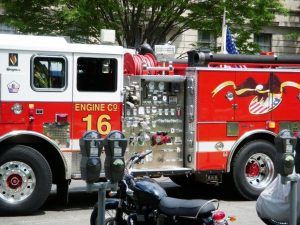The Federal Emergency Management Agency (FEMA) Assistance to Firefighters Grants (AFG) program is sponsoring a $1.4 million study being conducted at the University of Arizona to find ways to reduce emergency responder injuries and fatalities. It is hoped that the findings will help find ways to reduce traffic accident collisions involving emergency vehicles.
These types of accidents are far too common. In fact, the second leading cause of death among fire fighters across the country is emergency vehicle accidents. Since 1994, emergency vehicle collisions have resulted in over 1000 injuries annually and more than 390 fatalities. While passenger car fatalities have dropped in the past ten years, fatalities in emergency vehicle crashes have not.
Currently, safety experts think that emergency truck and emergency vehicle collisions can be prevented with a few strategies:
1) Better driver training.
Emergency responders face issues that other drivers do not. Someone driving a police car, fire truck, or ambulance will generally need to travel at very high speeds to offer assistance in an emergency situation where lives may be at stake. They will at times need to drive through heavy traffic and sometimes along unfamiliar parts of the city. With larger fire trucks, maneuvering a large truck through narrow city streets presents its own challenges. Additional driver training, including driver simulation programs that let drivers “experience” a wide range of weather and traffic conditions, can help drivers practice safe driving, even at unsafe speeds.
2) Better motorist training.
Florida already has laws in place that require drivers to slow down or move into a further lane if they see an emergency vehicle on the side of the road with lights flashing. There are also rules in place to ensure that drivers pull over to the side of the road and get out of the way when a fire truck or other emergency vehicle is speeding by with sirens on, trying to get to the scene of an accident. Unfortunately, as the number of right of way accidents in Hollywood and other cities shows, many people ignore these rules. Educating drivers about the importance of emergency vehicles and enforcing emergency vehicle rules can help make the street safer for emergency responders and all motorists. Education campaigns can be one place to start.
3) Use of black boxes or vehicle data recorders.
These information-gathering devices in trucks and emergency response vehicles can help experts analyze whether a driver is speeding or taking other risks. This can help authorities screen unsafe drivers, even when those drivers are emergency responders. This can help authorities discipline and screen drivers adequately, before a collision happens.
Have you been injured in a trucking collision involving an emergency vehicle? Your case may be more complicated than the average roadway accident because they vehicles are often owned by powerful municipalities and it can be harder to secure compensation in these cases in some situations. To find out whether you have a case, contact Flaxman Law Group today for a free accident consultation to talk about your options. Flaxman Law Group is a law firm with offices in Miami, Hollywood, and Homstead. We would be pleased to discuss our previous successful claims against municipalities and would be happy to review your options with you.
 Florida Injury Lawyer Blog
Florida Injury Lawyer Blog


